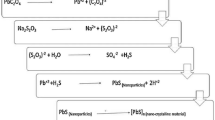Abstract
The purpose of this study is to elucidate the nature of the phase transformations of lead monoxide powder. Lead monoxide is prepared by calcination of a lead oxalate precursor salt, and its phase transformations are studied using X-ray diffraction (XRD), differential scanning calorimetry (DSC) and thermal gravimetric analysis (TG). Analysis reveals that the phase transformations observed for oxalate-derived lead monoxide powder are highly dependent on the firing atmosphere. In nitrogen, as the temperature is increased 1 deg/min from room temperature, lead monoxide undergoes a reconstructive litharge-to-massicot phase transformation in a temperature range of 525–575°C. In air, litharge, metastable at room temperature, slowly oxidizes to the Pb3O4 phase at a temperature of 350°C and rapidly reduces to litharge at 560°C. At temperatures greater than 560°C, litharge converts to massicot. With heating rates of 10 deg/min or higher, formation of Pb3O4 is not observed.
Zusammenfassung
Zweck dieser Untersuchung ist, das Wesen der Phasenumwandlungen von Bleimonoxidpulver zu ergründen. Bleimonoxid wird durch Calzinierung von Bleioxalat hergestellt und seine Phasenumwandlungen wurden mittels Röntgendiffraktion, DSC und TG untersucht. Die Analyse zeigt, daß die für das aus Oxalat erhaltene Bleimonoxidpulver beobachteten Phasenumwandlungen stark von der Heizatmosphäre abhängen. Wird die Temperatur ab Raumtemperatur mit einer Aufheizgeschwindigkeit von 1/min erhöht, geht Bleimonoxid in Stickstoff im Temperaturbereich 525°–575°C eine rekonstruktive Bleiglätte-Massicot-Phasenumwandlung ein. In Luft wird die bei Raumtemperatur metastabile Bleiglätte bei 350°C langsam zu Pb3O4 oxidiert und dann bei 560°C schnell zu Bleiglätte reduziert. Bei Temperaturen über 560°C wird Bleiglätte in Massicot umgewandelt. Bei Aufheizgeschwindigkeiten von über 10/min kann keine Bildung von Pb3O4 beobachtet werden.
Similar content being viewed by others
References
H. E. Brown, Lead Oxide Properties and Applications, International Lead Zinc Research Organization, Inc., New York 1985.
T. Ishii, R. Furuichi, T. Nagasawa and K. Yokoyama, J. Thermal Anal., 19 (1980) 467.
S. Y. Chen, S. Y. Cheng and C. M. Wang, J. Amer. Ceram. Soc., 73 (1990) 232.
M. Petersen, J. Amer. Chem. Soc., 63 (1941) 1302.
W. B. White, F. Dachille and R. Roy, J. Amer. Ceram. Soc., 44 (1961) 170.
I. Barin, Thermochemical Data of Pure Substances, Part II, VCH Publishers, New York 1989.
R. Soderquist and B. Dickens, J. Phys. Chem. Solids, 28 (1967) 823.
R. Clarke and F. Greene, Thin Solid Films, 66 (1980) 339.
C. A. Sorrell, J. Amer. Ceram. Soc., 55 (1972) 47.
I. J. Lin and S. Niedzwiedz, J. Amer. Ceram. Soc., 56 (1973) 62.
M. Senna and H. Kuno, J. Amer. Ceram. Soc., 54 (1971) 259.
D. Lewis, D. O. Northwood and R. C. Reeve, J. Appl. Crystallogr., 2 (1969) 156.
G. L. Clark and R. Rowan, J. Amer. Chem. Soc., 63 (1941) 1302.
Y. Sugahara, Y. Noshi, H. Naito, M. Saito, A. Takahashi and H. Tuchida, U. S. Patent 4, 117, 104, Sept. 26, 1978.
J. S. Nordyke, Lead in the World of Ceramics, American Ceramic Society, Columbus, OH 1984, p. 5.
L. Gordon, M. L. Salutsky and H. H. Williard, Precipitation from Homogeneous Solution, Wiley, New York 1959.
S. E. Morsi, U. A. R. J. Chem., 13 (1970) 1134.
M. Munson and R. E. Riman, Ceramic Transactions, Eds. H. C. Ling and M. F. Yan, Vol. 8, American Ceramic Society, Westerville, OH 1990, p. 213.
C. A. Sorrell, J. Amer. Ceram. Soc., 54 (1971) 501.
C. A. Sorrell, J. Amer. Ceram. Soc., 56 (1973) 613.
L. B. Pankratz, Thermodynamic Properties of Elements and Oxides, Bulletin 672, U.S.Bureau of Mines, U.S.Government Printing Office, Washington D. C. 1982.
M. W. Chase, Jr., C. A. Davies, J. R. Downey, Jr., D. J. Frurip, R. A. McDonald and A. N. Syverud, J. Phys. Chem. Ref. Data, Suppl., Vol. 14, 1985.
C. E. Wicks and F. E. Block, Thermodynamic Properties of 65 Elements: Their Oxides, Halides, Carbides and Nitrides, Bulletin 605, Bureau of Mines, U.S. Government Printing Office, Washington, D. C. 1963.
Gmelins Handbuch der Anorganischen Chemie, Lead, Ed. G. Hartke, Part C, Vol.1, System-Number 47, Verlag Chem., Weinheim/Bergstr. 1969.
Author information
Authors and Affiliations
Additional information
The authors would like to acknowledge the Center for Ceramic Research and the New Jersey State Commission on Science and Technology for the support of this research. The authors would also like to thank Ms. K. Griffin for her efforts in preparing this manuscript.
Rights and permissions
About this article
Cite this article
Munson, M.J., Riman, R.E. Observed phase transformations of oxalate-derived lead monoxide powder. Journal of Thermal Analysis 37, 2555–2566 (1991). https://doi.org/10.1007/BF01912800
Received:
Revised:
Issue Date:
DOI: https://doi.org/10.1007/BF01912800




